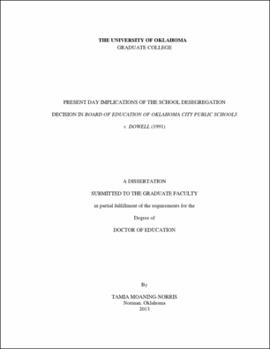| dc.contributor.advisor | Gutierrez, Kathrine||Rossow, Lawrence | |
| dc.creator | Moaning-Norris, Tamia Deshenne | |
| dc.date.accessioned | 2019-04-27T21:35:18Z | |
| dc.date.available | 2019-04-27T21:35:18Z | |
| dc.date.issued | 2013 | |
| dc.identifier | 99317993902042 | |
| dc.identifier.uri | https://hdl.handle.net/11244/319082 | |
| dc.description.abstract | This research study examined the segregate effects of the new geographic placement of John Marshall High School (JMHS) from a predominantly African American area to a predominantly Caucasian area. In Board of Education of Oklahoma City Public Schools (OKCPS) v. Dowell (1991), the Oklahoma City Public School district was released in 1991 from court-ordered desegregation efforts. Since release, the Oklahoma City Public Schools have become re-segregated and desegregation efforts have become lax. The un-acknowledgement of race as an important factor has important implications for public school education. Like most large, urban school districts, a large number of schools are color-coded. Partially because of residual state enforced residential segregation, the schools are mainly single-race schools-- predominantly attended by majority African American, or Hispanic students. School and residential segregation are inherently linked and difficult obstacles to overcome. Consequently, re-segregation is a major issue in OKCPS. Although, this re-segregation may be explained away through personal choice, it contrasts everything Mr. Dowell and so many others fought so very hard for in Dowell v. Board of Education of OKCPS (1963). | |
| dc.description.abstract | This research study sought to determine if the geographic relocation of JMHS represents inequality based on the results of the Board of Education of OKCPS v. Dowell (1991) case. The general research goal was to determine if, after release from court-ordered desegregation planning, OKCPS placed the issue of race relations in high importance when it relocated JMHS from one predominantly African American neighborhood to a predominantly Caucasian neighborhood displacing some former students to a nearby highly segregated high school, Oklahoma Centennial High School. The unintended consequence of this displacement of students was the creation of highly segregated, Oklahoma Centennial High School. The improvement of student integration at one school created segregation at another school. The racial majority makeup of the student population at JMHS changed due to relocation to a predominantly Caucasian neighborhood and displacement of students to a newly created segregated high school. The study investigated three research questions: | |
| dc.description.abstract | 1.Is the current re-segregation of the Oklahoma City Public Schools an unintended consequence or gradual result of the district being released from court-ordered desegregation planning in Board of Education of Oklahoma City v. Dowell (498 U.S. 237 (1991)? | |
| dc.description.abstract | 2.What types or kinds of desegregation data were used to identify a good geographic location for the placement of John Marshall High School to ensure adequate integration? | |
| dc.description.abstract | 3.How can Oklahoma City Public Schools ensure that all students enjoy a diversified, quality education in the future? | |
| dc.description.abstract | Data to inform the study were collected through OKCPS and Oklahoma City historical documents, demographic data, participant interviews, and personal introspection. Conclusively, it was found that OKCPS choose the current physical location for JMHS based on availability of needed space and cost factors. Additionally, OKCPS did reconfigure boundary lines after the opening of John Marshall High School at its new location. Specific to one school, this study is an effort to determine if student diversity was valued through the relocation of JMHS post BOE of OKC v. Dowell (1991). This study's data confirms that the dreams of the Dowell (1963-1991) court in terms of complete student integration have yet to be fully realized. | |
| dc.format.extent | 226 pages | |
| dc.format.medium | application.pdf | |
| dc.language | en_US | |
| dc.relation.requires | Adobe Acrobat Reader | |
| dc.subject | De facto school segregation--Oklahoma--Oklahoma City | |
| dc.subject | Segregation in education--Oklahoma--Oklahoma City | |
| dc.title | Present Day Implications of the School Desegreation Decision in Board of Education of Oklahoma City Public Schools v. Dowell (1991) | |
| dc.type | text | |
| dc.type | document | |
| dc.thesis.degree | Ed.D. | |
| ou.group | Jeannine Rainbolt College of Education::Department of Educational Leadership and Policy Studies | |
